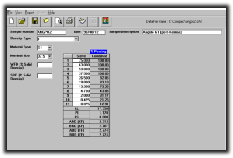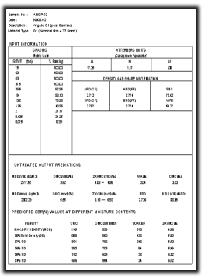
 |
|
Please note if you are
running windows 95 or 98 you will need to first install the DCOM98
drivers before you install COMPACT
PLEASE NOTE: No technical assistance can be provided for this software
 The
new CSIR COMPACT version 3.0 program is based on extensive research into
the influence of basic material properties (ie grading, Atterberg limits
and linear shrinkage) on the compactability of untreated and asphalt
road building materials. The
new CSIR COMPACT version 3.0 program is based on extensive research into
the influence of basic material properties (ie grading, Atterberg limits
and linear shrinkage) on the compactability of untreated and asphalt
road building materials.
In this research the effects of the shape and texture of the
aggregate particles as quantified by the shakedown bulk density (SBD)
and the weighted fractional density (WFD) on the compactability and
bearing capacity of materials were also investigated. Accurate
regression models were developed for the prediction of compactability
properties and bearing capacities for a range of densities and moisture
content levels.
The results of this research are contained in the COMPACT software,
which allows the roads engineer to use the results of this work with
ease and confidence
INPUT INFORMATION REQUIRED
- Atterberg limits (Casagrande method);
- ARD+4,75, BRD+4,75 and ARD-4,75, BRD-4,75;
- SBD and WFD;
- Grading after compaction;
- Linear shrinkage;

Figure 1: Typical data output
If the SBD and/or WFD values are unknown, it is still possible to
make reasonable predictions of the compactability properties - but not
of the bearing capacity.
The California Bearing Ratio (CBR) is predicted at the CMC, OMC
(lowest value of OMC(vib) or OMC(mod. AASHTO)) and "soaked"
condition for the following density levels (see Figure 2 below):

Figure 2: Typical tabular output
|

Figure 3: Grading curve graph |
The CBR is shown in both tabular and graphic form.
The program can also be used for asphalt mixes, i.e. coarsely graded
or fine to well-graded asphalt mixes (eg Porous, SMAs, continuously
graded and gap-graded mixes).
Properties that are predicted include:
- the optimum and zero air voids binder contents;
- BRD;
- binder film thickness;
- interparticle and total air voids;
- maximum theoretical density (Rice) for both the interparticle air
voids and total air voids.
The binder contents at 3% and 4% air voids are also predicted, as
well as the other properties mentioned above for these binder contents.
- Windows version is supplied;
- COMPACT is user friendly and easy to use;
- The input data and output results can be viewed on the screen,
printed out (input and results on the same A4 sheet) or saved as an
electronic file;
- Grading and bearing capacity graphs can be viewed on the screen,
printed or saved as an electronic file;
- COMPACT has been verified for a range of materials including
crushed stone (G1, G2), natural gravels, and sandy and clayey
materials (ranging from A-1 to A-7-6);
- Predictions may be expected to be accurate to within 10%;
- The software is able to discern whether the material has a coarse
or fine to well-graded grading. Materials on the coarse side of the
Talbot curve (n=0,51) are taken as coarse;
- The compactabiity models for coarse material are different from
the models for fine to well-graded materials. In the case of
untreated coarsely graded materials no prediction is made about the
bearing capacity (i.e. CBR) as too little information exists;
- The program has a choice of three sieve ranges, namely the
European, SA untreated and SA asphalt standard sieve ranges;
- It can also be used with equivalent non-metric sieve ranges (US
and British imperial), in which case the MDDs are expressed in
lb/ft3;
- Any of the three sieve ranges may be used to evaluate either
untreated or asphalt material;
- The graphs of the actual grading and of the adjusted grading (due
to differences between the BRDs of the coarse and fine fractions of
the grading) as well as that of the ideal grading (i.e. Talbot with
n=0,51) are also plotted on a log-linear scale to enable the
engineer to visualize the quality of the grading;
- When the SA untreated sieve range is used for untreated material
the grading envelopes for G1, G2, G3 and G4 aggregates for both 26,5
mm and 37,5 mm maximum particle sizes are plotted with the grading
curve. If the untreated material does not fall in any of these
classes it should just be listed as "other", in which case
the grading envelopes will fall away.
In order to use the full version of the Compact Version 3 program, please send your user key to the e-mail address below. A license code will be given to you. No technical assistance can be provided by CSIR.
CSIR BUILT ENVIRONMENT
PO Box 395
Pretoria
SOUTH AFRICA
0001
Fax: +27 12 842-7081
E-mail: rcastely@csir.co.za
|
